Building Our House III
As our regular readers know, we're building a house in Merida, several blocks south of where we live now, in Colonia San Sebastian. Many people who come to live here buy an old colonial building and restore it. There are some really beautiful buildings here, with columns and pasta-tile floors, that have been abandoned or neglected. It's a real pleasure to bring them back to life.
For the last five years, we have lived in one of those restored colonials. Now that we have two rather big dogs, we decided we needed something bigger. At the same time we decided to try something a little different. We bought a rather small and simple colonial house that was on a large piece of land. We saved the first two rooms of the house, with their high beamed ceilings and thick stone walls of mamposteria. But all the newer construction behind it was demolished and we are building a totally new home behind the colonial facade. Our design aesthetic is based on the notions of a renovated monastery with a modern Yucatecan ambiance.
The designers have created a plan, of course. The section shown to the left is of the inner courtyard with the front rooms of the house at the bottom and a passageway on the right. We spent quite a few meetings pouring over both the general plan and the electrical plan. We've decided to put ceiling fans in every room and outside on the terraces under the tejebans (which almost translates as "eaves". A tejeban is the structure built over an outside living area). We have been careful to place our lights and outlets where we are going to need them. Even though we have planned everything in advance, the albañiles will still build the walls and then carve out channels afterwards to put in the electrical and plumbing. That's just the way they do it here.
And we've also had a couple computer renderings done of what the completed structure is going to look like. The view below is of the inner courtyard, looking toward the back of the house. The rendering comes complete with guests in bathrobes (for scale, we suppose) enjoying the terrace outside their guestroom upstairs. Underneath the guestroom is the kitchen, with large floor-to-ceiling glass-and-iron doors to let in light and air. At the end of the passageway on the right is the backyard and the pool.
For the last few weeks, we have been refining the design of our home with our designers/ contractors. We have been visiting showrooms and deciding on floors, columns, finshes and tile designs so that we can more accurately understand how things will look and what our costs are going to be.
While we've been doing that, albañiles have been digging holes and pouring foundations, digging pozos (wells), locating and digging a new fosa septica, and finishing the perimeter walls. In the process of finishing one of the walls, the albañiles had to build a new outdoor laundry-washing station for one of the neighbors in order to replace the one they had been using that was where a wall needed to go.
Most of the work being done so far is by a team of masons. We're finding that this part of the work is the hardest to budget for, because it is the hardest to estimate. For instance, we had one number for the cost of building the perimeter wall, based on square meters. But once it was decided that the walls were going to have to go higher because the pool is being built above ground, not only did the square meters increase, but the rebar-reinforced towers that are built at intervals along the walls were going to have to be built closer together to accommodate the increased height. This was going to take longer and cost more. And so the inevitable increase in expenditures begins!
The photo to the right is the same view as the computer rendering, but as things look today. Notice the big hole on the left behind the man in the blue shirt? That's for the fosa septica, which is located under the courtyard. For decades, houses in Merida have worked with an elaborate French-drain type of system. There is a new, cheaper method now of dealing with human waste that involves installing a type of plastic septic tank. But it also requires maintenance and cleaning every two years, whereas the time-tested option only needs to be serviced every 10 years or so. We had to decide which to use. We opted for the traditional system and greater cost up front with lower maintenance in the future.
Most of our floors are going to be concrete, another low cost and low maintenance option. We have a lot of floors, so we needed something we could afford. In the exterior spaces, the concrete will be treated to look like terracotta and left a little rough like sandstone, so we don't slip when it rains. In the interior spaces, the concrete will be a buttery color and polished. In some rooms, we will have borders or central tapetes (rugs) of pasta tiles, because a house in the Yucatan without those beautiful mosaicos is like an Italian meal without wine.
Another thing we've been dealing with in the last few weeks are the utilities. When we bought the house, both the water and electricity bills had been paid up to date by the previous owner. Now we're trying to put those bills into our name, and there are always complications and of course, in Mexico, this sort of thing can never be done with just one visit.
In the case of the water bill, we've discovered that through some typo by a data entry clerk years ago (the house was abandonado (abandoned) for years before we bought it), our address became associated with two water "contracts". The one that was paid up has its own problems. We need the water company, called JAPAY, to install a new medidor (meter) because the old one has so much condensation inside, it's unreadable and the meter-reader can't take lecturas (readings) from it. The other erroneous contract has a past-due balance of over $8,000 pesos. That's over a hundred years of water bills at the normal rate. Needless to say, we aren't planning to pay that bill, but it's taking multiple visits to set the record straight and get the bill into the name of its rightful owner. That rightful owner is not going to be too pleased when their water bill finally catches up to them!
This week, the interior walls of the house are going up. There is nothing more exciting in the process than seeing two-dimensional plans suddenly turn into three-dimensional reality. In the next week or two we should be able to see the basic structure of our house spring into existence. After that, you'll be able to watch us agonize through the next few months of adding in all the rest of what makes a concrete block structure into a liveable home.
Stay tuned!




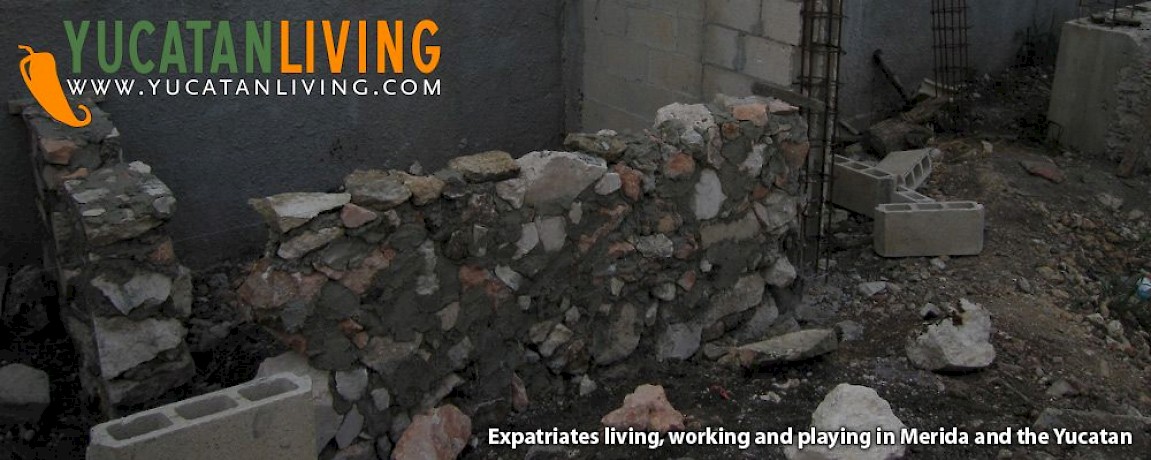


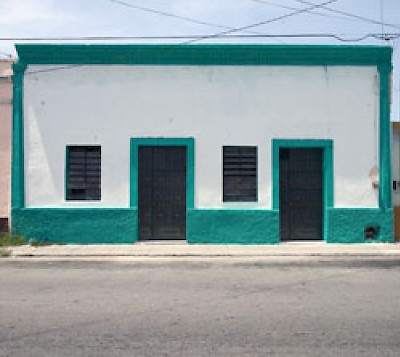
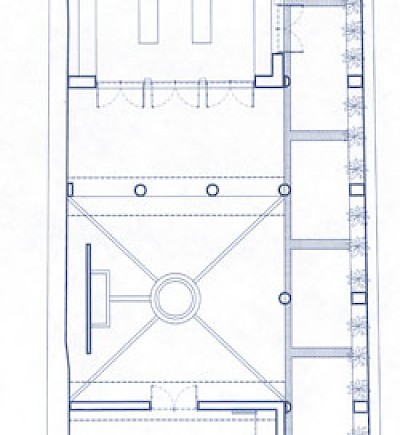
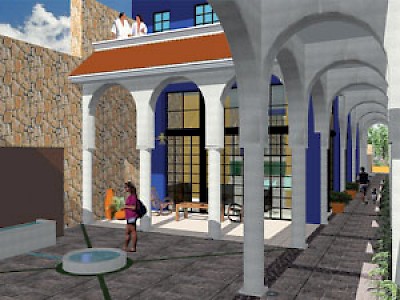
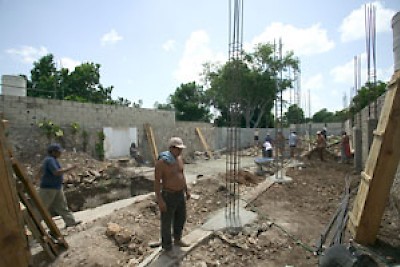
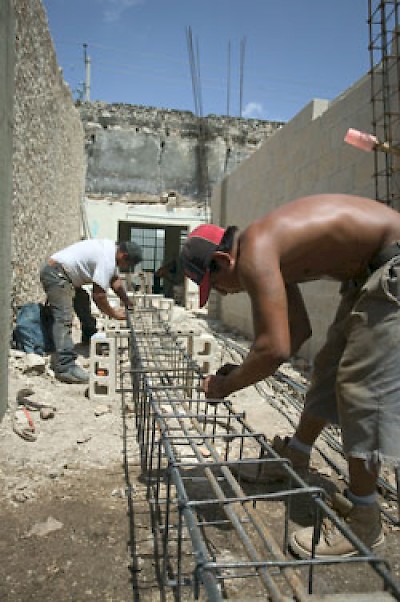

Comments
Working Gringos 18 years ago
Thanks, Casi. Exactamente.
Here are some links to some local architects if you want to pick their brains for additional information:
Henry Ponce: http://www.henryponce.com
Alvaro Ponce: http://www.yucatansol.com
Victor Cruz: http://www.estiloyucatan.com
Gabriela Cornelio: http://www.gcornelio.com/
Reply
CasiYucateco 18 years ago
Monica, I hope you don't mind me jumping in to help the Working Gringos with some ideas.
Lighting Fixtures can be handmade to order for very reasonable prices. There are some shops in Centro (including one rather popular one on a corner whose street numbers I cannot remember) who make a metal frame, insert the glass of your choice and wire it up to work. These would be "old style" Spanish lanterns, as well as various types of chandeliers. Yucatecos were quite fond of Europe and tried to imitate many European styles in their haciendas.
Also, concrete is used by workmen on site to make wonderful uplighting wall sconces. Hard to put into words, but if you can imagine a corner of a room with a sort of triangular cement 'cove' or 1/4 cone, large end up, with a bulb fitted inside, that would be it.
Old haciendas, of course, were lit with lanterns and chandeliers with lanterns or candles. Merida was one of the first fully electrified cities in Mexico, even having public street lights before many cities in the USA. (a lot of money came from those haciendas).
Plumbing supply companies are all over the city. Boxito is one ("little dark fellow" in Spanish/Mayan): http://www.boxito.com.mx/ and there are others.
Quite beautiful sinks can be made of cement by same craftsmen who put up the walls of the house. In fact, shelves and all sorts of decorative cornices are commonly made of cement. I've been quite impressed with all that is done with cement. Old haciendas had delicate porcelain sinks imported from Europe. I've seen many with a "toile" style of scenery. Also, sinks can be made in Dzitya of stone. Many families in Dzitya specialize in all sorts of stone carving. A beautiful stone bathroom sink bowl that sits above a shelf (rather than below the counter) costs well under $100.
Floors in older haciendas are commonly made of "pasta tile", so called from the 'paste' of color and cement that is compressed by huge presses and then cured. The colors and patterns are quite beautiful, they last forever, and you can have your own designs made, if you wish. Oftentimes, the tiles were in the pattern of a cement "rug" on the floor. (Wool doesn't do well in humidity.)
Modern furniture can be bought from departments stores, but more rustic furniture is sold alongside the road by the craftsmen themselves. A fellow from Veracruz shows up with loads of wicker furniture (and it quite proud of it) that he sells along the highway.
I guess to sum it all up: Most of the things you have done will not be done by big firms (well you can do it that way, for 10 times the cost). Most will be done by local craftsmen, with more or less local materials.
Finally, if your (imaginary) hacienda is in Yucatan, please do not use adobe to make changes or patch it up. The heavy tropical rains would dissolve it in no time. Older hacienda construction is always limestone rocks and lime cement. So, use cement and stone to be most authentic.
Building in Merida means "handmade."
Reply
Working Gringos 18 years ago
Hi Ray,
As a matter of fact, we do have recent fotos and some updates... we'll get them up soon! Stay tuned.
Reply
Ray 18 years ago
How goes the construction work, any recent updates on the work and how your planned budget is working out?
Reply
Monica 18 years ago
I'm sorry it has taken me so long to respond. I'm actually planning to just use adobe for the little bits of the structure that I'm changing. What is giving me a problem is finding distributors for plumbing and lighting fixtures, furniture dealers, paint companies and the like. I don't expect them to all have websites, but I have to be able to say where I would purchase the items I plan to use. So, if you know any information of this sort, please feel free to send it to monicamattingly@hotmail.com. And thanks for your help. It's very kind of you. Monica
Reply
ABIGAIL O'CONNOR 18 years ago
I have been enjoying your articles of the progress your home. I check constantly for updates. Would you please send the names of your architect/contractors to me also. We are trying to put together a package for a house that is basically a shell now. I want to get the financing for the improvements in with the basic mortgage. This means I would need the drawings and estimates for the work to present to the bank before they would fund. It would have to be done quickly in order to take the house off the market. I am coming down the first of Dec. if not before. Thanks for any information you can give me. I am also ordering the Casa Yucatan book today.
Reply
Working Gringos 19 years ago
Ray,
If you send us your email, we will be happy to pass it on to our architects/contractors. Hopefully, we will find time to do an article in the near future on whose available in the area.
Reply
Working Gringos 19 years ago
Dear Monica,
The most authentic Hacienda renovation would involve tearing down a Mayan archeaological structure to use the stone. This is how the oldest hacienda in Yucatan was built, namely Hacienda Chichen, where stones from Chichen Itza were used to build the casa principal. Needless to say, this kind of authenticity is no longer permitted.
Here in Merida, there are not many "companies" that do renovations. Usually, the process involves hiring an architect whose team creates the plans in Autocad, but then sub-contracts the labor to independents, most of whom are Mayans, who wouldn't know how to do it any other way than authentically. The architects seldom have a website (we're having a tough time finding any - although we know of several architects who do this kind of work).
The local experts in this field are Salvador Reyes, Alvaro Ponce and Henry Ponce. Their writings have been published in various venues (in Spanish), but not on the web (that we could find).
One English language book we know that discusses methods and materials is called Casa Yucatan. You can find it on Amazon.com.
As for furnishings, most of the haciendas were decorated using imports from France or Italy, then later from the United States or Mexico City. There was not much of a furniture tradition in Yucatan during the hacienda boom years.
Reply
Ray 19 years ago
I too would be interested in contractor names as well as architects as our retirement plans are to move to Merida from Vancouver, B.C. We want to be out of this crazy town well before the Olympics hit in 2010 and also capitalize on the spike in real estate values that have occurred here.
Reply
Monica 19 years ago
I was just wondering, I'm an interior design student at Mount Ida College. For my current project I'm "renovating" a hacienda 30 minutes outside of Merida. I'm supposed to use local materials and furnishings. I was just wondering... would you be able to post a few names of companies, especially if they have web sites I could look at? I've been having quite a time trying to do my research from Boston!!!
Thanks, Monica
Reply
Working Gringos 19 years ago
Hola Dan,
Sounds like fun! Our contractors have asked that we keep their contact information private at this time, due to scheduling issues on current projects (like ours!) but we will gladly forward your name and email to them so they can contact you directly.
Reply
« Back (30 to 41 comments)Next »